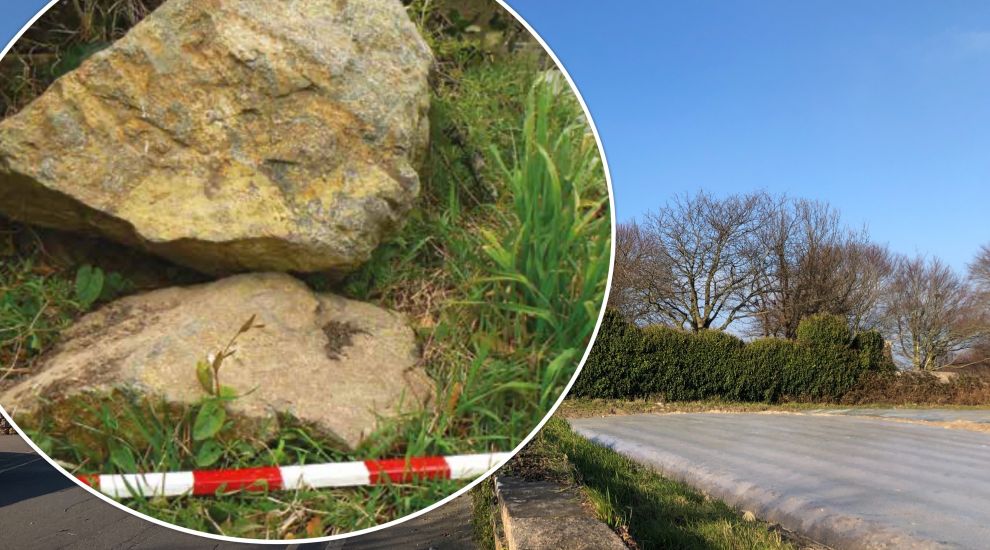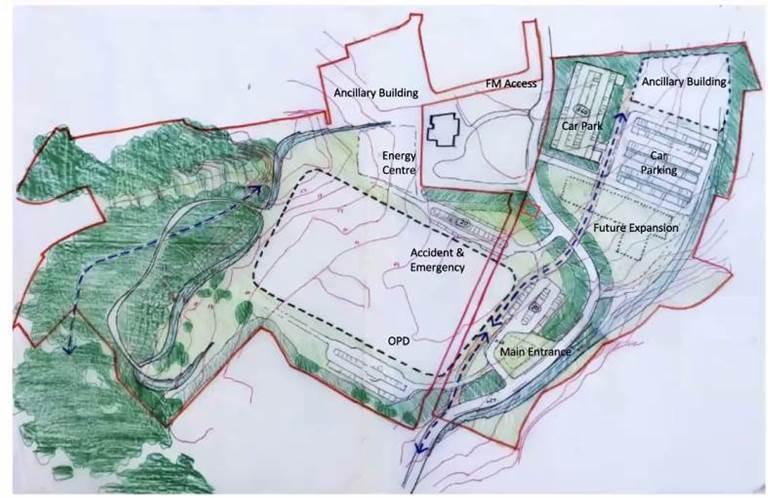


A field earmarked for an administrative block - and potentially a carpark - for the new hospital could be the site of a Neolithic monument, it has emerged.
The Société Jersiaise believe Field 1550 could be the ‘lost’ site of the Mont Patibulaire dolmen and want the chance to excavate it properly.
But the Government has the field, which sits opposite the crematorium and borders part of Mont à L’Abbé cemetery, in its sights to create a ‘Knowledge Centre’ as part of the new hospital campus.
As well as administrative offices, the C-shaped build would include staff wellbeing facilities, a library, seminar rooms and a 120-seat lecture theatre.
And, according to new plans released at a neighbourhood forum last week, the field is now also being considered as the sight of the main hospital car park - a shift from the original plan to build the carpark in the field directly opposite the current Overdale site.

Pictured: Plans shared with the neighbourhood forum last week showed a car park on Field 1550.
When attendees at the meeting asked whether there were any archeological factors that needed to be taken into account with the new design, Mark Furlonger, Director of environmental planning and sustainability firm Temple, said that a ‘desktop assessment’ conducted last September had found “nothing that we would otherwise call showstoppers."
He pledged a ‘watching brief’ would be kept during the building and planning process, but maintained that: “We did that early due diligence and what it tells us is that there’s nothing in there that could be considered significant.”
But the Société don't agree, saying there’s no real way of knowing what could be lost unless a proper excavation of the site is carried out.
The heritage group’s new President, Nicolette Westwood, told Express the fact Field 1550 features in the plans is of “concern” and that she believes it might be necessary to bring in commercial excavators to conduct an assessment, though she said that Société would be happy to assist. She said that the group had raised these concerns directly with the Government.
The reason the group believe the field to be special follows detailed research undertaken by member Nick Aubin.

Pictured: Original plans for the Knowledge Centre shared with States Members last year.
In 2018, he authored a report investigating where Jersey’s ‘lost’ Neolithic passages reside, concluding that Field 1550 was the site of the Rouge Bouillon/Mont Patibulaire megalith mentioned by historians in the 1700s and 1800s.
His conclusions hinged on “distinctive” chunks of rock found near the field’s entrance (pictured top).
“It’s a very distinctive rock with distinctive crystals… And I found an identical outcrop with the help of a geologist down south of the Victoria Marine Lake on the beach. It occurred to me that a quarryman on the hill isn’t going to go to the trouble of bringing rock from all the way down there up onto a hill, but the Neolithic people did drag rocks off the beach, coastal rocks, we’ve seen it at La Hougue Bie and elsewhere. So I thought it might possibly be one of the fragments of rock mentioned in the 1800s,” he told Express.
While there’s little to see in the field at present, Mr Aubin does not think that is a reason to believe the site does not have value. Jersey Heritage entered his findings into Jersey’s Historic Environment Record, and the site is designated as being of ‘moderate’ archeological potential.
Those factors were also flagged up to Planning, though the site still doesn’t benefit from any statutory protection.
“They can’t schedule it as a monument because we don’t know it’s there, but they’ve scheduled it as a field with archeological potential,” Mr Aubin explained.
Video: The field in question.
“Now one might think if all the stones are gone, there’s nothing there to see, nothing there to excavate. But, of course, you’ve got all the stone sockets there. The flooring would probably be the base of the floor, deposits on it would be covered with Occupation debris…so there is actually potentially quite a lot of archeology there.
“I’ve seen pictures of excavations in Newgrange in Ireland where some of the satellite dolmens were completely removed but if you excavate carefully, you can trace all the different stones. Of course, when then stones are pulled up it leaves the socket and the little stones that were supporting it. So you’ve still got the archeology even if the monument’s been culled off the top of it.”
What he doesn’t want to see is what happened at Mont Félard in the 1970s: “There was a dolmen up there, and there were a couple of stones left lying flat on the ground. That sadly was built on. It’s a shame to potentially destroy this without an adequate excavation.
“You won’t know until you excavate. If something’s going to happen, it should be looked at properly because once it’s gone, it’s gone.”
Asked how they would be navigating the challenge thrown up by this potential heritage feature, Heritage Advisor to the Our Hospital Project, Steven Bee, told Express it was likely that “anything of historical interest or importance in the field is already in a fragmentary state due to repeated ploughing.”
He continued: “That said, as the scheme is at an early master-planning stage, the Delivery Partner will continue to take account of this as part of overall heritage matters. This will involve a watching brief and trial trenching to monitor any remains as part the building work, in line with best industry practice and considering this is a site with no statutory protection.
“There will not be a separate planning application in relation to this site as it will form part of the main hospital and access planning application, which will carefully take into account all of the historical aspects of the project.”
Read more about the history of the site in Express tomorrow...
Comments
Comments on this story express the views of the commentator only, not Bailiwick Publishing. We are unable to guarantee the accuracy of any of those comments.